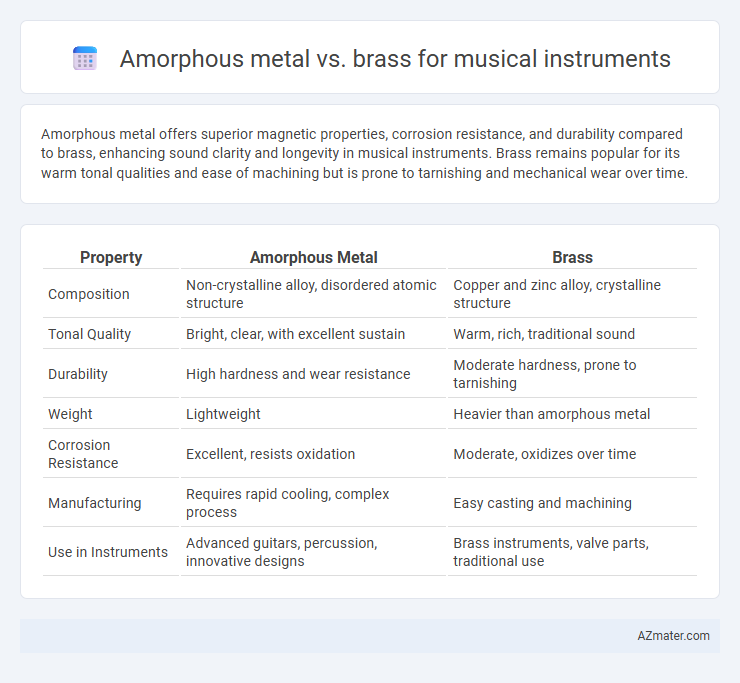Amorphous metal offers superior magnetic properties, corrosion resistance, and durability compared to brass, enhancing sound clarity and longevity in musical instruments. Brass remains popular for its warm tonal qualities and ease of machining but is prone to tarnishing and mechanical wear over time.
Table of Comparison
| Property | Amorphous Metal | Brass |
|---|---|---|
| Composition | Non-crystalline alloy, disordered atomic structure | Copper and zinc alloy, crystalline structure |
| Tonal Quality | Bright, clear, with excellent sustain | Warm, rich, traditional sound |
| Durability | High hardness and wear resistance | Moderate hardness, prone to tarnishing |
| Weight | Lightweight | Heavier than amorphous metal |
| Corrosion Resistance | Excellent, resists oxidation | Moderate, oxidizes over time |
| Manufacturing | Requires rapid cooling, complex process | Easy casting and machining |
| Use in Instruments | Advanced guitars, percussion, innovative designs | Brass instruments, valve parts, traditional use |
Introduction to Amorphous Metal and Brass in Musical Instruments
Amorphous metal, known for its non-crystalline atomic structure, offers exceptional strength, corrosion resistance, and magnetic properties, making it increasingly popular in high-performance musical instruments. Brass, a traditional alloy of copper and zinc, has been widely used for centuries due to its excellent machinability, tonal warmth, and durability, especially in brass winds like trumpets and trombones. Comparing these materials highlights how amorphous metals can enhance sound quality and durability, while brass remains valued for its classic acoustic characteristics and ease of craftsmanship.
Material Composition and Structure Comparison
Amorphous metals consist of a non-crystalline atomic structure with a random arrangement of atoms, resulting in high strength and excellent corrosion resistance compared to traditional crystalline metals like brass, which is primarily an alloy of copper and zinc with a well-ordered grain structure. The lack of grain boundaries in amorphous metals allows for improved elasticity and durability, enhancing the tonal clarity and longevity of musical instruments. Brass offers good machinability and a warm, resonant sound due to its crystalline structure, but it is more prone to wear and environmental degradation than amorphous metals.
Acoustic Properties: Resonance and Sound Quality
Amorphous metal exhibits superior acoustic properties in musical instruments due to its high elasticity and low internal friction, resulting in enhanced resonance and clearer, more sustained sound quality compared to brass. Brass, while valued for its warm tonal characteristics and durability, often produces a more muted resonance because of its crystalline structure and higher internal damping. Instruments made from amorphous metals deliver brighter, more precise tones with extended sustain, making them ideal for applications where sound clarity and resonance are paramount.
Durability and Longevity of Amorphous Metal vs Brass
Amorphous metal exhibits superior durability compared to brass due to its non-crystalline atomic structure, which enhances resistance to wear, corrosion, and fatigue. This structural advantage results in greater longevity, making amorphous metal instruments less prone to deformation and surface damage over time. Brass, while commonly used and acoustically versatile, tends to degrade faster under rigorous playing conditions due to its crystalline grain boundaries that facilitate stress accumulation and corrosion.
Manufacturing and Cost Efficiency
Amorphous metals offer superior corrosion resistance and magnetic properties but require complex manufacturing processes like rapid solidification, increasing production costs compared to brass. Brass, being easier to cast and machine with established industrial methods, provides cost-efficient manufacturing suitable for mass production of musical instruments. The higher raw material and processing expenses of amorphous metals often limit their economic feasibility despite performance advantages.
Weight and Handling Differences for Musicians
Amorphous metal offers a significantly lighter weight compared to brass, enhancing ease of handling and reducing player fatigue during extended performances. Its superior strength-to-weight ratio allows for thinner, more ergonomically designed components without compromising durability. Musicians benefit from improved balance and quicker responsiveness, making amorphous metal instruments a preferable choice over traditional brass counterparts.
Tuning Stability and Consistency
Amorphous metal outperforms brass in tuning stability and consistency due to its non-crystalline atomic structure, which reduces internal stress and deformation over time. Brass, while traditionally favored for tonal warmth, tends to experience more dimensional changes under temperature and humidity fluctuations, impacting tuning reliability. The enhanced structural stability of amorphous metal ensures more consistent pitch retention, making it ideal for precision musical instruments.
Corrosion Resistance and Maintenance
Amorphous metal exhibits superior corrosion resistance compared to brass, making it highly durable in various environmental conditions and reducing the risk of tarnishing and degradation over time. Brass, while traditionally favored for its acoustic properties, requires regular cleaning and polishing to prevent corrosion, especially in humid or salty environments. Instruments made from amorphous metal benefit from lower maintenance demands, extending their lifespan and ensuring consistent performance.
Applications in Various Musical Instruments
Amorphous metals, known for their high strength, corrosion resistance, and excellent magnetic properties, are increasingly utilized in precision components of musical instruments such as pickups for electric guitars, where enhanced magnetic responsiveness improves sound clarity. Brass, a traditional alloy of copper and zinc, remains a preferred material for wind instruments like trumpets and trombones due to its superior acoustic resonance, workability, and bright tonal quality. The choice between amorphous metal and brass depends on the specific application requirements: amorphous metals enhance electronic sound components, while brass excels in acoustic instrument bodies.
Future Trends and Innovations in Instrument Materials
Amorphous metal offers superior magnetic properties and enhanced durability compared to traditional brass, making it a promising material for future musical instruments. Innovations in amorphous alloys enable lighter, corrosion-resistant components with improved acoustic precision, fostering new design possibilities and sound quality enhancements. Emerging research focuses on integrating amorphous metal with traditional materials to create hybrid instruments that balance tonal warmth and advanced performance characteristics.

Infographic: Amorphous metal vs Brass for Musical instrument
 azmater.com
azmater.com